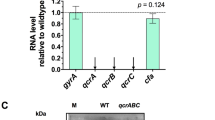Abstract
Bacterial quinones were extracted with pentane, and homologues or other quinones were reincorporated. In spite of the redox potential difference of 110 mV, menaquinone and demethylmenaquinone could replace each other in aerobic electron transport and fumarate respiration ofHaemophilus influenzae RAMC 18 Bensted andProteus mirabilis Harding & Nicholson. The enzymes involved may recognize the naphthoquinone structure and are not specific for menaquinone or demethylmenaquinone. Ubiquinone was not replaced in aerobic electron transport by naphthoquinones withPseudomonas fluorescens 28/5 Rhodes orAcinetobacter sp. 661/60 Mannheim, probably owing to the specificity for benzoquinones of the enzymes involved, since the redox potential difference between demethylmenaquinone and ubiquinone is only 76 mV.Haemophilus parainfluenzae 429 Pittman, which resembles aerobic bacteria with respect to the terminal electron transport system, could incorporate demethylmenaquinone or menaquinone. This organism seems to be defective in the synthesis of naphthoquinones but possesses the enzyme system for fumarate respiration.Haemophilus influenzae RAMC 18 Bensted, which produces only demethylmenaquinone, seems to be defective in synthesizing ubiquinone, but it also possesses the enzymes for a ubiquinonemediated aerobic respiration.
Similar content being viewed by others
Literature Cited
Bishop, D. W., Pandya, K. P., King, H. K. 1962. Ubiquinone and vitamin K in bacteria. Biochemical Journal83:606–614.
Callies, E. 1979. Untersuchungen zur Systematik und Physiologie einiger der GattungFlavobacterium Bergey et al. 1923 zugeschriebener chemoorganotropher Bakteriengruppen. Ph.D. Thesis, Marburg.
Callies, E., Mannheim, W. 1978. Classification of theFlavobacterium/Cytophaga complex on the basis of respiratory quinones and fumarate respiration. International Journal of Systematic Bacteriology28:14–19.
Collins, M. D., Pirouz, T., Goodfellow, M., Minnikin, D. E. 1977. Distribution of menaquinones in actinomycetes and corynebacteria. Journal of General Microbiology100:221–230.
Collins, M. D., Shah, N. H., Hardie, J. M. 1980. Lipids in the classification ofBacteroides and related taxa. Czechoslovak Society for Microbiology, Conference on Taxonomy, Computer Identification of Bacteria and Diagnostic Methods. Czechoslovakia: Liblice Castle.
Ernster, L., Lee, I. Y., Norling, B., Persson, B. 1969. Studies with ubiquinone-depleted submitochondrial particles. European Journal of Biochemistry11:328–340.
Hess, A., Holländer, R., Mannheim, W. 1979. Lipoquinones of some spore-forming rods, lactic acid bacteria and actinomycetes. Journal of General Microbiology.115:247–252.
Holländer, R. 1976. Physiologie und Physiotaxonomie einiger Vertreter der GattungHaemophilius Winslow et al. Ph.D. Thesis, Marburg.
Holländer, R. 1976. Correlation of the function of demethylmenaquinone in bacterial electron transport with its redox potential. FEBS Letters72:98–100.
Holländer, R. 1980. Characterization ofErwinia-strains by their respiratory quinones and enzymes of fumarate metabolism. Zentralblatt für Bakteriologie, I. Abteilung Originale C 1:243–258.
Holländer, R., Mannheim, W. 1975. Characterization of hemophilic and related bacteria by their respiratory quinones and cytochromes. International Journal of Systematic Bacteriology25:102–107.
Holländer, R., Wolf, G., Mannheim, W. 1977. Lipoquinones of some bacteria and mycoplasmas, with considerations on their functional significance. Antonie van Leeuwenhoek43:177–185.
Kröger, A., 1977. Phosphorylative electron transport with fumarate and nitrate as terminal hydrogen acceptors. Symposia of the Society for General Microbiology27:61–93.
Kröger, A., Dadák, V. 1969. On the role of quinones in bacterial electron transport. The respiratory system ofBAcillus megaterium. European Journal of Biochemistry11:328–340.
Kröger, A., Dadák, V., Klingenberg, M., Diemer, F. 1971. On the role of quinones in bacterial electron transport. Differential role of ubiquinone and menaquinone inProteus rettgeri. European Journal of Biochemistry21:322–333.
Mannheim, W., Stieler, W., Wolf, G., Zabel, R. 1978. Taxonomic significance of respiratory quinones and fumarate respiration inActinobacillus andPasteurella. International Journal of Systematic Bacteriology28:7–13.
Minnikin, D. E., Goodfellow, M., Collins, M. D. 1978. Lipid composition in the classification and identification of coryneform and related taxa, pp. 85–160. In: Bousfield, I. J., Callely, A. G. (eds.), Coryneform bacteria. London: Academic Press.
Ruckelshausen, R., Holländer, R. 1978. On the phenotypical characteristics ofHaemophilus isolates from human respiratory tract. Zentralblatt für Bakteriologie, I. Abteilung Originale A242:500–511.
Whistance, G. R., Dillon, J. F., Threlfall, D. R. 1969. The nature, intergeneric distribution and biosynthesis of isoprenoid quinones and phenols in Gram-negative bacteria. Biochemical Journal111:461–472.
White, D. C. 1965. The function of 2-demethyl vitamin K2 in the electron transport system toHaemophilus parainfluenzae. Journal of Biological Chemistry240:1387–1394.
Yamada, Y., Inouye, G., Tahara, Y., Kondo, K. 1976. The menaquinone system in the classification of aerobic Gram-positive cocci in the generaMicrococcus, Staphylococcus, Planococcus, andSporosarcina. Journal of General and Applied Microbiology22:227–236.
Yamada, Y., Ishikawa, T., Tahara, Y., Kondo, K. 1977. The menaquinone system in the classification of the genusNocardia. Journal of General and Applied Microbiology23:207–216.
Author information
Authors and Affiliations
Rights and permissions
About this article
Cite this article
Holländer, R. The dependence on quinone specificity of terminal electron transport of bacteria. Current Microbiology 6, 155–159 (1981). https://doi.org/10.1007/BF01642390
Issue Date:
DOI: https://doi.org/10.1007/BF01642390




